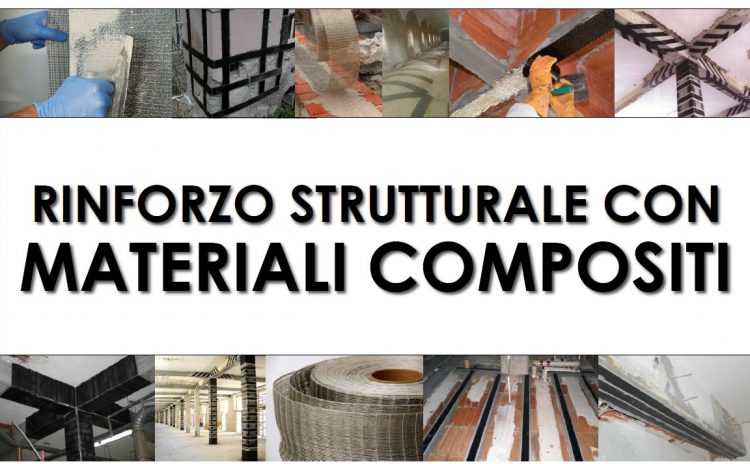RINFORZO STRUTTURALE CON MATERIALI COMPOSITI
STRUCTURAL REINFORCEMENT WITH COMPOSITE MATERIALS
- 28 Apr 2019

Diversi sono i materiali disponibili per il rinforzo degli elementi strutturali. Un tipo particolare è costituito dai materiali compositi.


FIBRE DI VETRO
Esistono vari tipi di fibre di vetro (E, A, C, CR, R, S, D), con diverse proprietà a seconda degli usi (resistenza chimica, proprietà elettriche…).
La resistenza delle fibre di vetro migliora grazie ad un sistema di rivestimento usato per trattare la superficie.
Il sistema di copertura è un rivestimento organico che permette di proteggere le fibre, aumentarne la resistenza e migliorare la compatibilità con la matrice (agenti accoppianti).

FIBRE DI CARBONIO
Esistono due tipi di fibre:
• HM (High modulus) – alto modulo di Young ma bassa resistenza a trazione
• HS (High strengh) – basso modulo di Young e alta resistenza a trazione

→ Modulo elastico molto alto
→ Massa volumica bassa
→ Coefficiente di dilatazione termica basso
→ Costi di produzione elevati
FIBRE DI ARAMIDE
Le fibre aramidiche (ARomatic poly-AMIDes) sono fibre sintetiche realizzate sulla base di poliammidi aromatiche. Vengono prodotte tramite processi di polimerizzazione, estrusione e stiramento.
→ Alta resistenza meccanica
→ Alto modulo elastico
→ Bassa resistenza alla temperatura
→ Bassa resistenza al logorio

FIBRE DI BASALTO
Il basalto è una roccia vulcanica che subisce un trattamento di fusione e filatura per ottenere fibre continue.
→ Ottimi isolanti termici e acustici
→ Stabili chimicamente (ambiente acido e alcalino)
→ Mantengono le proprietà meccaniche ad alte temperature
→ Resistenti alle vibrazioni (rinforzo di strutture di autostrade, ferrovie, metropolitane)

FIBRE DI ACCIAIO
Le fibre di acciaio sono composte da filamenti di acciaio ad elevata resistenza meccanica.
Le fibre vengono rivestite da uno strato di ottone o di zinco galvanizzato che garantisce una buona resistenza alla corrosione. Le fibre di acciaio hanno un’elevata capacità di adattarsi alla geometria del supporto, rendendo semplice l’applicazione e diminuendo la probabilità di rottura in corrispondenza degli spigoli.

FIBRE NATURALI
Le fibre naturali sono quelle già presenti in natura e ricavabili con procedimenti meccanici e chimici.
• Vegetali (cotone, lino, canapa, agave, juta, sisal…)
• Animali (lana, seta)
• Minerali (amianto, basalto)
Svantaggi delle fibre naturali:
• Assorbimento di umidità
• Attacchi di microbi e funghi
• Bassa resistenza alle alte temperature
Nel rinforzo strutturale vengono usati tessuti in fibra di lino e in fibra di canapa, sia in matrici polimeriche che in matrici di malta.


MATERIE PLASTICHE
Le materie plastiche dal punto di vista chimico sono dei polimeri
(naturali o sintetici) costituiti da grosse molecole formate dall’unione di atomi di C, H, O, N, in catene più o meno lunghe.
Le catene possono essere di forma lineare, lineare ramificata o legate tra loro in strutture reticolate.
• Termoplastiche – quando si presentano in forma compatta, si ammorbidiscono sotto alte temperature e riprendono compattezza raffreddandosi
• Termoindurenti – lo stato plastico passa allo stato indurito per determinate combinazioni di calore e pressione, o grazie a delle reazioni chimiche
→ Basso modulo di elasticità
→ Bassa conducibilità termica
MATRICI PLASTICHE
Le matrici plastiche sono costituite da resine termoindurenti, la loro struttura si degrada in maniera irreversibile quando la temperatura raggiunge un certo limite.
Prima della messa in opera si presentano come un fluido più o meno viscoso a cui vengono aggiunti dei catalizzatori (nel caso di matrici poliestere) o indurenti (negli altri casi) che fanno avviare il processo di reticolazione dei polimeri.
Le caratteristiche meccaniche della matrice hanno poca influenza su quelle del composito, costituiscono però la parte esposta all’ambiente. Sono quindi importanti:
• la resistenza a corrosione
• la resistenza al calore
• la resistenza all’abrasione
RESINE POLIESTERE
Basso costo, facilmente lavorabili, induriscono a temperatura ambiente
RESINE EPOSSIDICHE (utilizzo in edilizia)
Buone caratteristiche meccaniche, alto costo, messa in opera più laboriosa, buona capacità di adesione al supporto
RESINE FENOLICHE
Buone capacità di resistenza a temperature elevate
RESINE SILICONICHE
Costituite da polimeri inorganici – resistenza a temperature molto elevate
MATRICI DI MALTA
Costituite da un legante idraulico pozzolanico
MATERIALI COMPOSITI VS MATERIALI TRADIZIONALI
VANTAGGI
• Alta resistenza specifica (rapporto resistenza/densità)
• Alta rigidezza specifica (rapporto modulo di Young/densità)
• Anisotropia (progettazione in funzione della direzione di sollecitazione)
• Leggerezza (non si aggiungono carichi alla struttura)
• Adattabilità alla geometria del supporto
• Reversibilità dell’intervento (controversa)
SVANTAGGI
• Anisotropia (complessità di calcolo)
• Alta sensibilità a sbalzi igro-termici
• Bassa resistenza al fuoco
• Bassa traspirabilità
• Costi elevati
• Necessità di manodopera specializzata
FRG/SRG vs FRP/SRP
(matrice di malta) (matrice polimerica)
VANTAGGI
• Compatibilità chimica e fisica con il supporto
• Alta resistenza al fuoco
• Alta resistenza ai raggi UV
• Traspirabilità (scambi termo-igrometrici)
• Migliore operatività in cantiere (anche in termini di procedure di sicurezza)
• Pulizia degli attrezzi
• Migliore adesione al supporto (funziona anche da rasante)
SVANTAGGI
Minore impregnazione delle fibre (si sta studiando l’impiego di matrici di malta cementizia polimero-modificata con una migliore aderenza matrice/fibre)
Fonti:
https://www.itsantisismica.it/
 Ing. Andrea Petrarca – ZED PROGETTI srl
Ing. Andrea Petrarca – ZED PROGETTI srl
Different materials are available for the reinforcement of structural elements. Composite materials are a particular type.
GLASS FIBRES
There are various types of glass fibres (E, A, C, CR, R, S, D), with different properties depending on the use (chemical resistance, electrical properties…).
The resistance of glass fibres improves thanks to a coating system used to treat the surface.
The covering system is an organic coating that protects the fibres, increases their resistance and improves compatibility with the matrix (coupling agents).
CARBON FIBRES
There are two types of fibres:
– HM (High modulus) – high modulus of Young but low tensile strength
– HS (High Strengh) – low Young’s modulus and high tensile strength→ Very high modulus of elasticity
→ Low density mass
→ Low coefficient of thermal expansion
→ High production costsARAMID FIBRES
Aramid fibres (ARomatic poly-AMIDes) are synthetic fibres made from aromatic polyamides. They are produced by polymerization, extrusion and stretching processes.
→ High mechanical resistance
→ High modulus of elasticity
→ Low temperature resistance
→ Low resistance to wear and tear
BASALT FIBRES
Basalt is a volcanic rock that undergoes a melting and spinning process to obtain continuous fibres.
→ Excellent thermal and acoustic insulation
→ Chemically stable (acid and alkaline environment)
→ Maintain mechanical properties at high temperatures
→ Vibration resistant (reinforcement of motorway, railway and underground structures)STEEL FIBRES
Steel fibres are made of steel filaments with high mechanical resistance.
The fibers are coated with a layer of brass or galvanized zinc which ensures good corrosion resistance. Steel fibres have a high capacity to adapt to the geometry of the substrate, making it easy to apply and reducing the probability of breakage at the edges.NATURAL FIBERS
Natural fibres are those already present in nature and can be obtained by mechanical and chemical processes.
– Plants (cotton, linen, hemp, agave, jute, sisal…)
– Animals (wool, silk)
– Minerals (asbestos, basalt)
Disadvantages of natural fibres:
– Moisture absorption
– Microbial and fungal attacks
– Low resistance to high temperatures
In structural reinforcement, linen and hemp fibre fabrics are used, both in polymeric and mortar matrices.PLASTIC MATERIALS
Chemically speaking, plastics are polymers.
(natural or synthetic) consisting of large molecules formed by the union of atoms of C, H, O, N, in chains more or less long.
The chains can be linear, branched linear or linked together in reticulated structures.
– Thermoplastics – when presented in compact form, they soften under high temperatures and regain compactness by cooling down.
– Thermoset – the plastic state changes to the hardened state for certain combinations of heat and pressure, or thanks to chemical reactions
→ Low modulus of elasticity
→ Low thermal conductivityPLASTIC MATRICES
Plastic matrices are made of thermosetting resins, their structure degrades irreversibly when the temperature reaches a certain limit.
Before installation, they appear as a more or less viscous fluid to which catalysts are added (in the case of polyester matrices) or hardeners (in other cases) that initiate the process of cross-linking the polymers.
The mechanical characteristics of the matrix have little influence on those of the composite, but are the part exposed to the environment. They are therefore important:
– resistance to corrosion
– heat resistance
– abrasion resistancePOLYESTER RESINS
Low cost, easy to work, harden at room temperature
EPOSSIDIC RESINS (use in construction)
Good mechanical properties, high cost, more laborious installation, good adhesion capacity to the substrate
PHENOLIC RESINS
Good resistance to high temperatures
SILICONE RESINS
Made of inorganic polymers – very high temperature resistance
MORTAR MATRICES
Consisting of a pozzolanic hydraulic binderCOMPOSITE MATERIALS VS. TRADITIONAL MATERIALS
BENEFIT
– High specific resistance (resistance/density ratio)
– High specific stiffness (Young/density module ratio)
– Anisotropy (design according to the direction of stress)
– Lightness (no loads are added to the structure)
– Adaptability to the geometry of the substrate
– Reversibility of intervention (controversial)DOWNSIDE
– Anisotropy (calculation complexity)
– High sensitivity to hygro-thermal changes
– Low fire resistance
– Low breathability
– High costs
– Need for skilled labourFRG/SRG vs FRP/SRP
(mortar matrix) (polymer matrix)BENEFIT
– Chemical and physical compatibility with the support
– High fire resistance
– High UV resistance
– Breathability (thermo-hygrometric exchanges)
– Improved operation on site (also in terms of safety procedures)
– Cleaning tools
– Better adhesion to the substrate (also works as a smoother)DOWNSIDE
Less fibre impregnation (the use of polymer-modified cementitious mortar matrices with better matrices/fibres adhesion is being studied)

